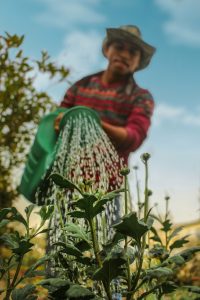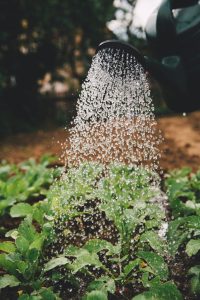Maintaining the proper moisture level in the soil is crucial for the healthy growth of plants. Overwatering can lead to waterlogged soil and root rot, while underwatering can cause plants to wilt and die. Therefore, it’s important to understand how long soil should stay wet after watering to ensure that your plants receive the right amount of water they need. In this article, we will explore the different factors that affect soil moisture, discuss how to water plants properly, explain how to check soil moisture levels and emphasize the importance of tailoring watering practices to specific plants. By the end of this article, you will better understand how to keep your plants healthy and thriving.
Contents
Factors That Affect Soil Moisture
Several factors can influence how long soil stays wet after watering. These include:
- Soil type: Different soil types have different water-holding capacities, affecting how long the soil stays wet after watering. For example, clay soils tend to hold onto water longer than sandy soils.
- Climate: The amount and frequency of rainfall in a given area can affect how quickly the soil dries out after watering. In dry and arid climates, the soil may dry out quickly, while in humid and rainy climates, the soil may stay wet for longer periods.
- Plant water requirements: Different plants have varying water needs; some require more water than others. Understanding the water requirements of the plants you are growing is important for determining how long soil should stay wet after watering.
- Drainage: Proper drainage is essential for maintaining the right moisture level in the soil. Poorly drained soil can lead to waterlogging, damaging plant roots and promoting harmful microorganisms’ growth.
- Watering technique: How you water your plants can also affect how long the soil stays wet. For example, the soil may stay wet for longer if you water plants too frequently or with too much water. On the other hand, if you water too infrequently, the soil may dry out too quickly.
 By understanding these factors, you can better determine how often and how much to water your plants to ensure the soil stays moist but not soggy.
By understanding these factors, you can better determine how often and how much to water your plants to ensure the soil stays moist but not soggy.
How to Water Plants Properly
Watering plants properly is critical to their health and growth. Here are some pointers on how to properly water your plants:
- Water deeply and thoroughly: When you water your plants, make sure to saturate the soil to a depth of at least 6 inches. This ensures that the water penetrates the root zone of the plant, where most of the roots are located. Shallow watering can lead to weak root development and poor plant growth.
- Allow the soil to dry out slightly: Before watering again, it’s important to let it dry out. This allows air to circulate the roots and prevents waterlogged soil, which can lead to root rot and other problems. To determine if the soil is ready for watering, stick your finger about an inch into the soil. If it feels dry at this depth, it’s time to water again.
- Water at the right time: It’s best to water your plants early or late in the afternoon when the temperatures are cooler. This helps to reduce water evaporation and allows the water to penetrate the soil more effectively.
- Water at the base of the plant: Avoid getting the leaves wet, as this can promote the growth of fungal diseases. Instead, water is at the base of the plant, directing the water to the soil around the roots.
By following these tips, you can ensure your plants receive the proper water they need for healthy growth. Remember to pay attention to the soil moisture levels and adjust your watering schedule to prevent over or under-watering.
How to Check Soil Moisture Levels
Checking the soil’s moisture level is essential for determining when to water your plants. Here’s how you can check the soil moisture level:
- Stick your finger into the soil: Sticking your finger about an inch is the easiest and most accurate way to check soil moisture levels.
- Use a moisture meter: Another option is to use a moisture meter. These devices can be inserted into the soil and give you a reading of the soil moisture level. Moisture meters are especially useful for plants with specific water requirements or for new gardeners to plant care.
Once you have determined the soil’s moisture level, you can decide whether or not to water your plants. Here’s what to do based on the soil moisture level:
- If the soil feels dry: If it feels dry at a depth of one inch, it’s time to water your plants. Water deeply and thoroughly, as discussed earlier, to ensure that the water reaches the roots.
- If the soil feels moist: If it feels moist at a depth of one inch, it’s best to wait before watering again. This will allow the soil to dry out slightly, which prevents waterlogged soil and root rot.

Regularly checking the soil moisture level can ensure your plants receive the proper water they need for healthy growth. Remember to adjust your watering schedule as needed based on the soil moisture level and the specific water requirements of your plants.
The Importance of Tailoring Watering Practices to Specific Plants
Watering practices should be tailored to the specific needs of the plants you are growing. Different plants have different water requirements, and it’s important to research the specific needs of your plants to determine the best watering schedule for them.
- Soil type: Different types of soil retain water differently. For example, sandy soil drains quickly and requires more frequent watering, while clay soil retains water and requires less frequent watering. It’s important to understand the water-holding capacity of your soil and adjust your watering schedule accordingly.
- Climate: The climate in which you are growing your plants can also affect their water requirements. Plants in hot, dry climates require more water than in cooler, moister climates.
- Plant type: Some plants prefer drier soil, while others prefer more moisture. For example, cacti and succulents are adapted to arid environments and require infrequent watering, while ferns and other moisture-loving plants require more frequent watering.
Tailoring your watering practices to the specific needs of your plants is essential for their health and growth. Overwatering can lead to waterlogged soil and root rot, while underwatering can cause wilting and poor growth. Researching the specific needs of your plants can help you determine the best watering schedule for them. Remember that soil, climate, and plant types can affect your plants’ water requirements. By understanding these factors and adjusting your watering practices accordingly, you can ensure that your plants receive the proper water they need for healthy growth.
How long should soil remain wet after being watered?
Proper watering practices are essential for healthy plant growth. It’s important to water plants deeply and thoroughly, allowing the water to penetrate their root zone. Checking the soil moisture level regularly and tailoring watering practices to the specific needs of your plants are also crucial for healthy growth.

Factors such as soil type, climate, and plant type can all affect your plants’ water requirements. Researching the specific needs of your plants can help you determine the best watering schedule for them.
More Posts :
Possums and Tomatoes: A Comprehensive Guide to Preventing Crop Damage in 2023
Is it Really Bad Luck to Kill a Grasshopper? Debunking the Myth in 2023





